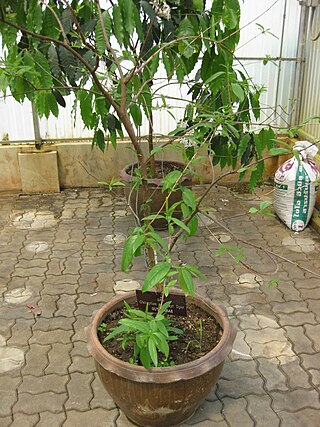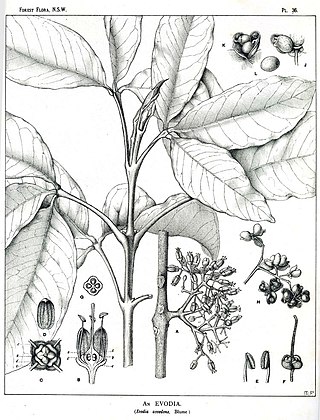
Cratoxylum maingayi is a plant in the family Hypericaceae. It is named for the botanist Alexander Carroll Maingay.
Hopea latifolia is a tree in the family Dipterocarpaceae. The specific epithet latifolia means "wide leaf".
Hopea sangal is a tree in the family Dipterocarpaceae. It is native to tropical Asia.
Melicope subunifoliolata is a plant of Borneo in the family Rutaceae. The specific epithet subunifoliolata is from the Latin meaning "nearly one leaf", referring to the almost unifoliolate leaves.
Barringtonia macrostachya grows as a shrub or tree up to 30 metres (100 ft) tall, with a trunk diameter of up to 95 centimetres (37 in). The bark is brown, greenish yellow, greyish brown or brown mottled grey. The fruits are obovoid, up to 9 cm (4 in) long. The specific epithet macrostachya is from the Greek meaning "large spike", referring to the inflorescence. Habitat is riverine and swamp forest, from sea level to 1,300 metres (4,300 ft) altitude. Local medicinal uses include the treatment of ringworm, sore eyes and stomach aches. B. macrostachya has been used as fish poison. It is found in China, Burma, Thailand, Vietnam, Malaysia, Brunei, Indonesia and the Philippines.
Epicharis densiflora is a tree in the family Meliaceae. The specific epithet densiflora is from the Latin meaning 'dense flowers'.
Anacolosa frutescens, also known as galo or galonut, is a plant in the family Olacaceae. The specific epithet frutescens is from the Latin frutex meaning 'shrub'. It produces edible fruits and nuts eaten in the Philippines.

Melicope accedens is a plant in the family Rutaceae.
Melicope confusa is a tree in the family Rutaceae.

Melicope denhamii is a plant in the family Rutaceae. It is named for the 19th century Royal Navy captain Henry Mangles Denham.
Melicope glabra is a tree in the family Rutaceae. The specific epithet glabra is from the Latin meaning 'hairless'.

Melicope triphylla is a plant in the family Rutaceae. The specific epithet triphylla is from the Greek meaning 'three leaf', referring to the trifoliolate leaves.

Semecarpus cuneiformis is a tree in the cashew and sumac family Anacardiaceae. The specific epithet cuneiformis is from the Latin meaning 'wedge-shaped', referring to the leaf base.
Castanopsis buruana is a tree in the family Fagaceae. The specific epithet buruana is from the Latin, meaning "of Buru".
Castanopsis costata is a tree in the family Fagaceae. The specific epithet costata is from the Latin meaning 'ribbed', referring to the leaf venation.
Castanopsis foxworthyi is a tree in the family Fagaceae. It is named for the botanist Frederick William Foxworthy.

Castanopsis javanica, the Javan chestnut-oak, is a tree in the beech family Fagaceae. The specific epithet javanica is from the Latin, meaning "of Java".
Castanopsis megacarpa is a tree in the family Fagaceae. The specific epithet megacarpa is from the Greek meaning 'large fruit'.

Lithocarpus elegans is a tree in the beech family Fagaceae. The specific epithet elegans means 'elegant', referring to the acorns and cupules.

Lithocarpus lucidus is a tree in the beech family Fagaceae. The specific epithet lucidus means 'shining', referring to the acorn and leaf surface.








